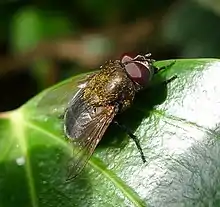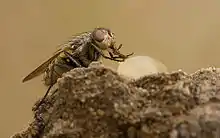| Polleniidae | |
|---|---|
 | |
| Pollenia | |
| Scientific classification | |
| Domain: | Eukaryota |
| Kingdom: | Animalia |
| Phylum: | Arthropoda |
| Class: | Insecta |
| Order: | Diptera |
| Superfamily: | Oestroidea |
| Family: | Polleniidae Brauer & Bergenstamm, 1889 [1] |

Pollenia rudis female
Polleniidae is a family of flies in the order Diptera. There are at least 6 genera and more than 190 described species placed definitively in Polleniidae, and other genera whose placement here is considered uncertain.[2] The largest genus is Pollenia, with close to 190 species of flies commonly called "cluster flies".[3][4]
The family Polleniidae has been considered a subfamily of Calliphoridae in the past, containing various genera and species. As a result of phylogenetic analysis, the subfamily Polleniinae was elevated to family rank by Cerretti, et al., in 2019,[5] and assigned the genera listed below.
Genera
- Alvamaja Rognes, 2010[6]
- Dexopollenia Townsend, 1917[7]
- Melanodexia Williston, 1893[8]
- Morinia Robineau-Desvoidy, 1830[9]
- Pollenia Robineau-Desvoidy, 1830[9] (cluster flies)
- Xanthotryxus Aldrich, 1930[10]
Incertae sedis
- Anthracomyza Malloch, 1928[11]
- Nesodexia Villeneuve, 1911[12]
References
- ↑ Brauer, F.; Bergenstamm, J. E. von (1889). "Die Zweiflugler des Kaiserlichen Museums zu Wien. IV. Vorarbeiten zu einer Monographie der Muscaria Schizometopa (exclusive Anthomyidae).Pars I". Denkschriften der Kaiserlichen Akademie der Wissenschaften. 56 (1): 69–180. Retrieved 25 November 2014.
- ↑ Gisondi, Silvia; Rognes, Knut; Badano, Davide; Pape, Thomas (2020). "The world Polleniidae (Diptera, Oestroidea): key to genera and checklist of species". ZooKeys (971): 105–155. doi:10.3897/zookeys.971.51283. PMC 7538466. PMID 33061774. Retrieved 22 June 2021.
- ↑ Sivell, Olga (2021). "Blow flies (Diptera: Calliphoridae, Polleniidae, Rhiniidae)". RES Handbooks for the Identification of British Insects. 10 (16): 1–208. ISBN 9781910159064.
- ↑ Pape, Thomas; Blagoderov, Vladimir; Mostovski, Mikhail B. (2011). Zhang, Zhi-Qiang (ed.). "Order Diptera Linnaeus, 1758. In: Zhang, Z.-Q. (Ed.) Animal biodiversity: An outline of higher-level classification and survey of taxonomic richness" (PDF). Zootaxa. 3148. doi:10.11646/zootaxa.3148.1.42. ISBN 978-1-86977-849-1. ISSN 1175-5326.
- ↑ Cerretti, Pierfilippo; Stireman, John O.; Badano, Davide; Gisondi, Silvia; et al. (2019). "Reclustering the cluster flies (Diptera: Oestroidea, Polleniidae)". Systematic Entomology. 44 (4): 957–972. doi:10.1111/syen.12369.
- ↑ Rognes, K (2010). "Alvamaja chlorometallica gen. n., sp. n. from Europe - the first metallic Rhinophoridae (Diptera)". Tijdschrift voor Entomologie. 153: 3–13. doi:10.1163/22119434-900000284. hdl:11250/182383.
- ↑ Townsend, C H T (1917). "Indian flies of the subfamily Rhiniinae". Records of the Indian Museum. 13: 185–202. doi:10.5962/bhl.part.5859.
- ↑ Williston, S. W. (1893). "List of Diptera of the Death Valley Expedition". N. Am. Fauna. 7: 235–268.
- 1 2 Robineau-Desvoidy, André Jean Baptiste (1830). "Essai sur les myodaires". Mémoires presentés à l'Institut des Sciences, Lettres et Arts, par divers savants et lus dans ses assemblées: Sciences, Mathématiques et Physique. 2 (2): 1–813. Retrieved 15 July 2018.
- ↑ Aldrich, J.M. (1930). "New two-winged flies of the family Calliphoridae from China" (PDF). Proceedings of the United States National Museum. 78: 1–15. Retrieved 30 June 2021.
- ↑ Malloch, J. R. (1928). "Notes on Australian Diptera, No. xvi". Proceedings of the Linnean Society of New South Wales. 53: 343–366. Retrieved 30 June 2021.
- ↑ Villeneuve, J. (1911b). "Diptères nouveaux recueillis en Syrie par M. Henri Gadeau de Kerville et décrits par le Dr. Joseph Villeneuve". Bulletin des Amis des Sciences Naturelles de Rouen. 1911: 40–54. Retrieved 28 June 2021.
This article is issued from Wikipedia. The text is licensed under Creative Commons - Attribution - Sharealike. Additional terms may apply for the media files.